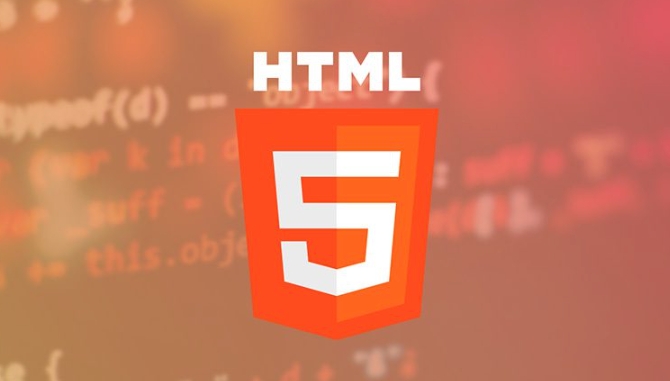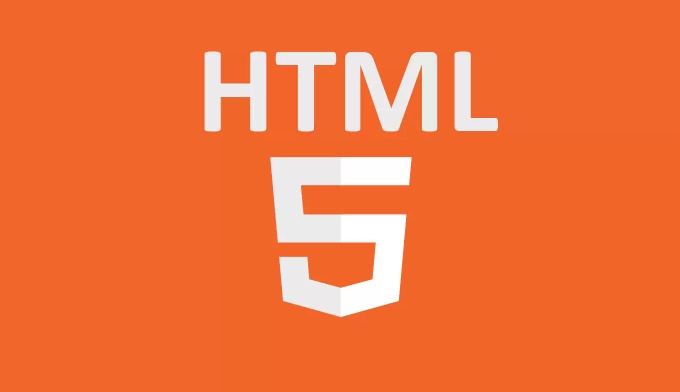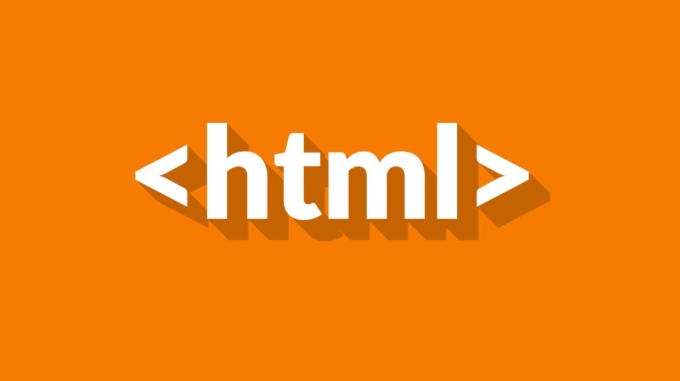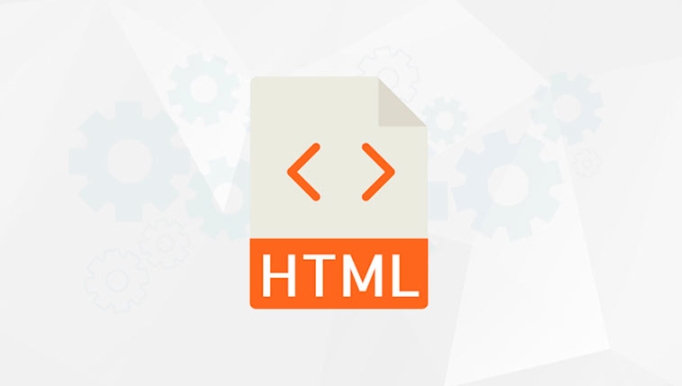DOM (Document Object Model) is a structured tree model that the browser converts HTML documents into, which is used to dynamically operate page content of the program. It treats each element, attribute, and text as an object with hierarchical relationships, forming a family tree-like structure, such as as the root node and
and as its child nodes. HTML is static text, while DOM is an operable interface generated by the browser after parsing HTML, allowing JavaScript to access and modify page content. Common operations include: 1. document.getElementById() gets the element; 2. document.querySelector() selects the first matching element; 3. element.innerHTML modify content; 4. element.addEventListener() binds the event. Notes include: ID must be unique; ensure that the DOM is loaded before executing the script; avoid frequent operation of the DOM to improve performance.
After the web page is loaded, the browser will convert HTML into a structured model to facilitate program operation and modify page content. This model is DOM (Document Object Model), which is essentially a tree-like representation of HTML documents.

What is DOM?
DOM treats every element, attribute, and even text in an HTML page as an object. There is a hierarchical relationship between these objects, forming a "tree". For example, is the root node, and its children are and , and there may be multiple child elements in , such as <div> , <code><p></p> , etc.
You can think of it as a genealogy: parent node, child node, brother node, and this structure is clear and intuitive. This way the browser understands the page structure and allows JavaScript to dynamically access and modify page content.

The relationship between DOM and HTML
HTML is a static text file, and it displays whatever you write. But once the browser parses this HTML, the corresponding DOM tree will be generated. This tree can be operated by JavaScript.
To give a simple example:

<p>Hello</p>
In HTML, it's just a tag. But in the DOM, it is an object that has properties such as tagName and textContent , and can also bind events, such as executing a piece of code when clicking.
In other words, HTML is the source data, and DOM is the browser's understanding and operation interface for it.
How to operate DOM with JavaScript?
JavaScript provides many ways to access and modify the DOM. Common ones include:
-
document.getElementById(): Get element based on ID -
document.querySelector(): Use CSS selector to get the first matching element -
element.innerHTML: Modify the HTML content inside the element -
element.addEventListener(): Add an event listener to the element
For example, if you want to change the text content of a paragraph, you can write it like this:
let para = document.getElementById("myParagraph");
para.textContent = "The content has changed!"; This line of code finds the element with ID myParagraph and then modify its text content. This is a common way for DOM to update pages dynamically.
Common precautions
- ID must be unique : if there is a duplicate ID on the page,
getElementByIdmay not work as expected. - DOM Loading Order : If your JS runs before an HTML element, the corresponding element may not be found. It is recommended to place the script in the
DOMContentLoadedevent, or at the end of. - Performance issues : Frequent operation of DOM will affect the performance of the page. For example, continuously modifying the node content in a large number of loops. It is best to process it in memory first and then insert it once.
DOM is one of the foundations of front-end development. Understanding how it cooperates with HTML can give you better control over page behavior. Basically all that is, it’s not difficult but it’s very critical.
The above is the detailed content of The Document Object Model (DOM) and HTML. For more information, please follow other related articles on the PHP Chinese website!

Hot AI Tools

Undress AI Tool
Undress images for free

Undresser.AI Undress
AI-powered app for creating realistic nude photos

AI Clothes Remover
Online AI tool for removing clothes from photos.

Clothoff.io
AI clothes remover

Video Face Swap
Swap faces in any video effortlessly with our completely free AI face swap tool!

Hot Article

Hot Tools

Notepad++7.3.1
Easy-to-use and free code editor

SublimeText3 Chinese version
Chinese version, very easy to use

Zend Studio 13.0.1
Powerful PHP integrated development environment

Dreamweaver CS6
Visual web development tools

SublimeText3 Mac version
God-level code editing software (SublimeText3)
 Implementing Clickable Buttons Using the HTML button Element
Jul 07, 2025 am 02:31 AM
Implementing Clickable Buttons Using the HTML button Element
Jul 07, 2025 am 02:31 AM
To use HTML button elements to achieve clickable buttons, you must first master its basic usage and common precautions. 1. Create buttons with tags and define behaviors through type attributes (such as button, submit, reset), which is submitted by default; 2. Add interactive functions through JavaScript, which can be written inline or bind event listeners through ID to improve maintenance; 3. Use CSS to customize styles, including background color, border, rounded corners and hover/active status effects to enhance user experience; 4. Pay attention to common problems: make sure that the disabled attribute is not enabled, JS events are correctly bound, layout occlusion, and use the help of developer tools to troubleshoot exceptions. Master this
 Configuring Document Metadata Within the HTML head Element
Jul 09, 2025 am 02:30 AM
Configuring Document Metadata Within the HTML head Element
Jul 09, 2025 am 02:30 AM
Metadata in HTMLhead is crucial for SEO, social sharing, and browser behavior. 1. Set the page title and description, use and keep it concise and unique; 2. Add OpenGraph and Twitter card information to optimize social sharing effects, pay attention to the image size and use debugging tools to test; 3. Define the character set and viewport settings to ensure multi-language support is adapted to the mobile terminal; 4. Optional tags such as author copyright, robots control and canonical prevent duplicate content should also be configured reasonably.
 Best HTML tutorial for beginners in 2025
Jul 08, 2025 am 12:25 AM
Best HTML tutorial for beginners in 2025
Jul 08, 2025 am 12:25 AM
TolearnHTMLin2025,chooseatutorialthatbalanceshands-onpracticewithmodernstandardsandintegratesCSSandJavaScriptbasics.1.Prioritizehands-onlearningwithstep-by-stepprojectslikebuildingapersonalprofileorbloglayout.2.EnsureitcoversmodernHTMLelementssuchas,
 HTML for email templates tutorial
Jul 10, 2025 pm 02:01 PM
HTML for email templates tutorial
Jul 10, 2025 pm 02:01 PM
How to make HTML mail templates with good compatibility? First, you need to build a structure with tables to avoid using div flex or grid layout; secondly, all styles must be inlined and cannot rely on external CSS; then the picture should be added with alt description and use a public URL, and the buttons should be simulated with a table or td with background color; finally, you must test and adjust the details on multiple clients.
 How to associate captions with images or media using the html figure and figcaption elements?
Jul 07, 2025 am 02:30 AM
How to associate captions with images or media using the html figure and figcaption elements?
Jul 07, 2025 am 02:30 AM
Using HTML sums allows for intuitive and semantic clarity to add caption text to images or media. 1. Used to wrap independent media content, such as pictures, videos or code blocks; 2. It is placed as its explanatory text, and can be located above or below the media; 3. They not only improve the clarity of the page structure, but also enhance accessibility and SEO effect; 4. When using it, you should pay attention to avoid abuse, and apply to content that needs to be emphasized and accompanied by description, rather than ordinary decorative pictures; 5. The alt attribute that cannot be ignored, which is different from figcaption; 6. The figcaption is flexible and can be placed at the top or bottom of the figure as needed. Using these two tags correctly helps to build semantic and easy to understand web content.
 What are the most commonly used global attributes in html?
Jul 10, 2025 am 10:58 AM
What are the most commonly used global attributes in html?
Jul 10, 2025 am 10:58 AM
class, id, style, data-, and title are the most commonly used global attributes in HTML. class is used to specify one or more class names to facilitate style setting and JavaScript operations; id provides unique identifiers for elements, suitable for anchor jumps and JavaScript control; style allows for inline styles to be added, suitable for temporary debugging but not recommended for large-scale use; data-properties are used to store custom data, which is convenient for front-end and back-end interaction; title is used to add mouseover prompts, but its style and behavior are limited by the browser. Reasonable selection of these attributes can improve development efficiency and user experience.
 How to handle forms submission in HTML without a server?
Jul 09, 2025 am 01:14 AM
How to handle forms submission in HTML without a server?
Jul 09, 2025 am 01:14 AM
When there is no backend server, HTML form submission can still be processed through front-end technology or third-party services. Specific methods include: 1. Use JavaScript to intercept form submissions to achieve input verification and user feedback, but the data will not be persisted; 2. Use third-party serverless form services such as Formspree to collect data and provide email notification and redirection functions; 3. Use localStorage to store temporary client data, which is suitable for saving user preferences or managing single-page application status, but is not suitable for long-term storage of sensitive information.
 Implementing Native Lazy Loading for Images in HTML
Jul 12, 2025 am 12:48 AM
Implementing Native Lazy Loading for Images in HTML
Jul 12, 2025 am 12:48 AM
Native lazy loading is a built-in browser function that enables lazy loading of pictures by adding loading="lazy" attribute to the tag. 1. It does not require JavaScript or third-party libraries, and is used directly in HTML; 2. It is suitable for pictures that are not displayed on the first screen below the page, picture gallery scrolling add-ons and large picture resources; 3. It is not suitable for pictures with first screen or display:none; 4. When using it, a suitable placeholder should be set to avoid layout jitter; 5. It should optimize responsive image loading in combination with srcset and sizes attributes; 6. Compatibility issues need to be considered. Some old browsers do not support it. They can be used through feature detection and combined with JavaScript solutions.






